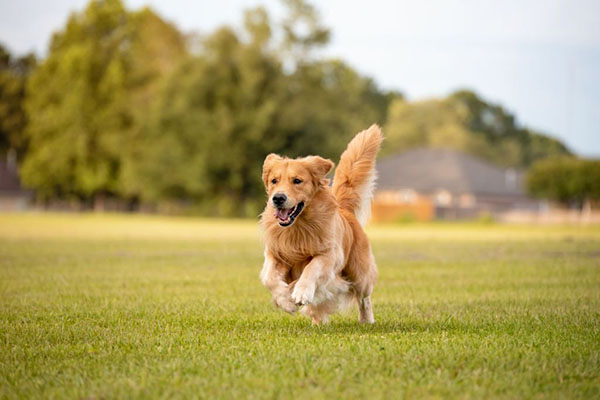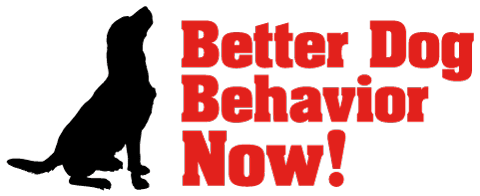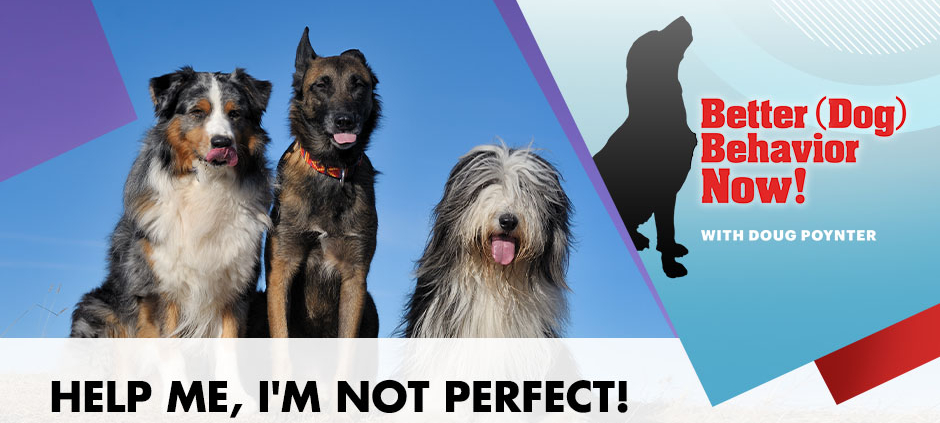Help Me, I’m Not Perfect!
Sometimes dog owners seem perfectionists and become too unrealistic about how their dogs behave. But, hey, no one’s perfect, not even our pets! This episode is packed with insights from Doug Poynter on how well-behaved our dogs need to be. He reminds dog owners that we shouldn’t expect more of our dogs’ behavior than humans. Doug also shares some insights on the socialization of dogs. Tune in to this episode to hear more from Doug Poynter.
—
Listen to the podcast here
Help Me, I’m Not Perfect!
I’m the Owner of Better Dog Behavior Now located in Richmond, Virginia. I service Central Virginia. I also service clients around the country and the world. I have had Zoom clients in Nicaragua, Southern California, and all over the world. Face to face, I work with people right here in Central Virginia. I do dog obedience training but more of my style. What I’m hired for is behavior problems in dogs like canine behavior problems. I work with aggressive dogs, fearful dogs, dogs with separation anxiety, and any type of behavior problem that you can have with dogs.
I use positive reinforcement in my training. I do not believe in aversive. I’ll do whatever I can to keep from having to do a correction. If I ever have to do a correction on a dog, it’s because I’m not good enough at the moment to be able to figure out an exercise I can teach the dog that what would keep the dog from performing the behavior we don’t want it to perform. My goal is to never have to correct the dog. It works better that way if you’re not correcting dogs. They work a whole lot better for positive reinforcement. I use marker training or clicker training to solve the behavior problems that my clients have with their dogs. This is not going to be a long session, just some things that have come up that I’d like to talk about.
One of the things that leads into the basic talk topic I want to cover in this episode is the idea of how well-behaved our dogs need to be. Sometimes, we humans are a little unrealistic in what we want from our dogs. I’ll give you an example. I had folks contact me years ago. A couple who makes their living, traveling and doing videos in different localities around the world. It seemed to me this is a cool way to make a living because they get to see the world. They get to create YouTube videos and videos that I’m assuming based on what they told me that travel agencies make use of or the local communities have as part of the promotions they do to try to get people to come to visit and take vacations.
We, humans, are a little unrealistic in what we want from our dogs. Click To TweetI don’t know for sure that’s where their products are viewed. The only thing I know is they travel the country and the world in an RV doing local videos in communities and different areas of this country. They travel with their three dogs. Here’s why they contacted me. They had originally contacted an organization that does board and train. They refer people to me if they feel that they would rather not handle it. That is a serious behavior problem. In this instance, they didn’t want YouTube exposure because whatever videos they do, they loaded up to YouTube.
They didn’t want their training business to be shown on YouTube in case they felt like these folks were dissatisfied with what they did. I’m not going to say the name of the organization that referred me or the name of the folks who do this video. There are hundreds of people who do things like this. I’m going to keep everybody safe and secure by not releasing any names. I will tell you that when they contacted me, they said the reason why they wanted help is that they had 2 dogs that they had gotten or raised together, and a third dog that they had picked up in another country, which was a feral dog that they rescued. The problems that they face were not huge, but the three dogs would get in a scrap every now and then.
It seemed to be centered around the feral dog. It hasn’t had a lot of socialization with people and maybe not with other dogs. Maybe the dog was out on its own. I don’t know what the background was. The feral dog is the one that seemed to be causing the problems. They wanted me to help them solve the behavior problems that they had around dogs scuffling, getting in spats, little fights over food, and other things that dogs fight about. I did a Zoom session with them. We talked about dominance and how dominance is not a factor when we’re dealing with our dogs, and how that’s a misnomer.
If you’ve been reading my blogs, then you know where that comes from. The dominance theory is a theory and error. It comes from wolves. The science behind a real wolf pack shows that there is no dominance in the pack. The leaders in the wolf pack are mom and dad and the rest of the pack of their pups. There’s cooperation. Wolfs work together as part of a team to survive. There’s very little structure and conflict in a wolf pack, not what we had assumed all these years. We had that discussion in the Zoom prep session I did with them. They asked me what it would be like to work with me. They were going to be here in Richmond, Virginia at some point.
Passing through, they would spend some time going from one area to another in the country in Richmond, Virginia. It might be a time that we could work together. They wanted to know what that would be like. I described to them how I work, how I come to them and the things that I do. They seemed like very positive and interested in doing this.
After the meeting, we put down some potential times to work. Two days later though, I got an email from them and they wanted me to describe how I could guarantee that their dogs would not fight again after working with me. You can’t guarantee anything when animals are concerned. I wasn’t going to say, “After you work with me, your dogs will never fight again.” I told them, “Anybody who does guarantee you something like that, I would run away from those folks as quickly as possible because that’s a money drain that you’re going to be involved with. No one can guarantee that type of thing.”
It didn’t seem like they were happy with that. I said, “Let’s be honest. These are animals. You can’t ever guarantee that animals are not going to fight.” I asked them a question. I said, “Could you guarantee that you as a couple won’t get into an argument again if you had kids? Could you guarantee that your kids are not going to fight? We know the answer to that right off.”
Dogs Are Animals
This was one of many instances I’ve noticed that human owners want dogs to behave more politely than humans and expect more from a dog than they expect from humans, kids even adults. If they don’t get that behavior then or that level of politeness and great behavior, then they think that the dog is a failure and there’s something wrong. Dogs are animals. We know that. That’s obvious. Animals don’t behave in a uniform fashion every moment of every day. It’s not going to happen. These folks were not happy when I said that. I never heard from them again.
In reality, it’s probably best because if they had gone into it with me thinking that’s what the result was going to be, they would never have to work on their dogs, train again or do any behavior modification. Behavior problems are not training problems. Some of the most highly trained dogs in the world have behavior problems and reactivity to other dogs, for example sometimes with people and they’re very highly trained. Behavior modification is what solves behavior problems.

Dog Behavior: Behavior problems are not training problems. Some of the most highly trained dogs in the world have behavior problems.
If they were going to think that some training and behavior modification upfront would create a perfect dog, they never have to revisit this and that’s what they wanted from a training experience, I was happy not to get their business because that’s not going to happen. I have my clients all the time. I’ll give you an example. I’ve got a client with a lovely female Great Dane, who’s one of the best dogs you’ve ever seen in your life. She’s fast and she works. I tell my client, “We should do a little bit more with this dog. We could do some type of obedience training with her, sit work and all kinds of things because she works.”
She’s not slow. She’s very fast and she’s got a lot of drive to work but the reason I was hired was not because of that. It’s because she had been attacked by a dog when she was younger so she had serious reactivity to other dogs. When she saw other dogs, she would drag her owner down the road. I’m not talking about walking fast and the owner following behind her. I’m talking about the owner laying on the ground, being dragged down the road by a Great Dane. I was hired to solve that problem, which we did. We take her on walks with my groups.
She can walk 10 feet or 15 feet from another dog, look at the dog and be fine but every now and then, she’ll have a backslide and some type of situation will come up that you can’t anticipate in training that is another thing that we need to work on. Her owner will call me on the telephone and I will help her over the phone. If we can get it covered that way, we go ahead and get it covered. If not, we need to do a session on some behavior modification in a new situation.
She’s greatly improved. She can get along in society but that doesn’t mean everything is 100% where it needs to be. Some things come up that you’ve got to work on like with humans. One of the things I want to encourage you to realize is that an expectation that you’re going to have a perfectly behaved dog, like what you see on TV, which is a produced scenario, is they only show you what they want you to see on TV. You don’t see it in real life.
If what you’re expecting is a dog is going to behave properly in every scenario and situation and you’re not going to have to do any type of further training or behavior modification, then you’re asking more of a dog than we expect from humans, normal humans, people in the public eye and people in politics. We want our dogs to behave better than the average human. That’s not realistic.
I don’t want you to think, A) You’re doing anything wrong or B) Your dog is doing anything wrong if you see some scenarios or things that need to continue to be worked on. That is normal. That’s one of the things that’s come up here. I want to get that out and I hope that didn’t sound like a rant but it is something that folks need to understand.
To me, that’s the fun of it to continue to work on different scenarios. This is true if you have a rescue dog because we don’t know what the background of your rescue dog is. What I always tell my clients is when you see stuff coming up, you’re starting to see evidence of what went on in your dog’s life before you got your dog. You got to be ready to go to work and do additional training and behavior modification if you have a behavior problem. That’s one thing I wanted to cover.
The next thing is what we don’t think enough about as owners. That is the socialization of the dog. Who the dog is hanging out with? Let me tell you a story to try to describe what I mean. I was driving down the road one day and my car has got a wrap on it where I’ve got a nice silhouette of a dog and a sit. I’ll have people drive up to me and beat the horn. I roll down my window and they’ll say, “Can you work with kids?” I have a little thing on my car that says, “We solve behavior problems.” That’s across the back of my car. I have people say, “Can you help me with my kids or my husband?” I go, “No, I can’t do that. I worked with dogs.”
A guy drove up next to me when the light turned red so we both stopped. He turned around and beeped the horn. When I turned around and saw him, he was rolling his window down so I also rolled my window down. He said, “I’ve got a German Shepherd. She’s crazy.” I go, “What do you mean?” He goes, “She’s out of control, way wound up and hyped up.” I said, “Does she want to bite people?” He said, “No. She’s just way excited. I can’t walk her because she’s so hyped up. She pulls me down the road and jumps on everybody. She’s like a crazy dog.”
A former client that I’d had in his situation is what caused me to ask this guy at the stoplight a question. I said, “Where does she spend most of her time?” He said, “I’ve got a nice big pen out in the backyard and she spends most of her time in the pen in the backyard.” I said, “There’s your problem.” He said, “What do you mean?” We were saying this fast because the stoplight was going to turn real quick so it didn’t take anywhere near as long as it’s taking me to explain this to you.
Some studies show that dogs would rather be around people than other dogs. I said to him, “Your dog is excited because she’s happy to see you. Part of the problem is she’s isolated. Dogs do not do good in isolation. They’re social animals.” He said, “Can I talk with you more about this?” I went, “Sure, my phone number is on the outside of the car. Give me a call.” We finished the conversation over the telephone.
Dogs do not do well in isolation. They're social animals. Click To TweetI told him, “Let me give you an example of what I’m talking about. I had a client who told me he had a female German Shepherd that was not very polite. She didn’t want to hurt anybody but she jumped all over people and it was very unpleasant to be around her.” I went to go visit the guy. He lives on the edge of the country. He’s at the very edge of suburbia. You go one block and we’re in the country. It’s a country setting. It’s got a big backyard with a fence around it.
When I got there, he met me outside and I said, “Where’s your dog?” He said, “She’s out back.” We went to the backyard and I said, “Where does she stay?” He goes, “She stays out here.” I said, “Is she ever in the house?” He said, “No. I don’t believe in having dogs in the house.” I said, “That’s your problem.” He said, “What do you mean?” I said, “Let me walk in.”
I walked in and she was so excited to see me. It was like, “I’ve been rescued. A person is here to see me.” She was running back and forth, jumping and putting her paws on my chest. He said, “See? This is so impolite.” I said, “She is just excited because she doesn’t have enough contact with humans.” He goes, “I walk out here every now and then.” I said, “That’s not what this dog needs.”
I’m telling this guy who called me on the telephone from the trip as we were driving down the road and he saw me in my car. I said, “I taught that guy into letting me bring his dog into the house.” I said to him, “I’d be willing to bet you that if we bring her into the house, it won’t take long before she settles down.” He was like, “I don’t know. I’ve kept all my dogs outside. That’s the way I do it.” I said, “I get it but you’re going to see a difference.”
His issue was the dog was so crazy outside jumping all over us that he was afraid she was going to do that when we walked inside. We put her on a leash. I walked her to the guy’s house on a leash. We went and sat down. It didn’t take that dog more than about five minutes of roaming a little bit. She came and lay down on the floor right next to him. I went, “Do you see? She needs to be around people.” My new friend that I had met in traffic, I’m telling him on the telephone, “You need to get your dog out of that pen and bring your dog in the house.”
He was more open to it than my client out in the country. He said, “I’ll do that.” I said, “You’ll see a difference. I do encourage you that you take her for a nice long walk before you do that and then bring her in the house, and let her be around you and your wife.” He was retired and didn’t have a family living in the house anymore. It was him and his wife.
I said, “Let her be around you and your wife. Let’s see how long it takes her to settle down. If she doesn’t settle down and she’s crazy, then you need a session with me, but if she comes into the house and does what I think she’s going to do, which is once she’s in the house and she’s near you, if you are not paying a huge amount of attention to her, you’re not fawning all over her, making her the center of your very lives in that house, she will settle down, relax, and become part of your household. You don’t need a session with me.”
I like making money as much as anybody, but I don’t see any need to charge somebody for a session when solving the problem is easy. He said, “I’ll try that. If it doesn’t work, I’ll call you back.” It’s been about years and I haven’t heard from him. I want to ask you to think about this. Does your dog get enough socialization with the family? Is your dog in the house? Does your dog get enough quality exercise? Do you take your dog on nice long walks? Do you allow the dog in the house with the whole family?
Fawning All Over The Dog
While the dog is in the house with the whole family, is everybody going about their business or is everybody fawning all over the dog? If you’re fawning all over the dog, this is creating excitement as well. The dog should be part of your household, but you shouldn’t be all over the dog and focused on the dog every minute that it’s with you. You don’t do that with kids, so you wouldn’t do that with a dog. It’s everyday life.
My dog is asleep on her dog bed down the hallway. I’m doing this episode from my study and she’s on her dog bed. She’s not in here with me. She doesn’t need to be in here with me. I haven’t kept her from being in here with me. It’s that she’s in the house enough that she’s with me enough that it’s not that big of a deal. It’s not a novelty. That’s what we need. We need exercise. We need the dog to be with you and your family. We have a more settled dog.
When your dog is with you and your family, keep in mind, your dog is not going to be perfect or an angel all the time. That doesn’t mean that the dog should be banished outside, you’ve got a bad dog or you need to get rid of your dog at the shelter. It means you might need to do some training or behavior modification. Remember, dogs are animals. They’re the best animals. They’re a gift from God, which is dog spelled backward. You can figure that out. Dogs have been instrumental in helping us civilize our world but they’re animals nonetheless.

Dog Behavior: Your dog will not be perfect, but that doesn’t mean that you should banish the dog outside. That doesn’t mean that you’ve got a bad dog.
If we expect them to behave better than we expect people to behave, we’re being a little bit unrealistic. If we expect them to survive and thrive isolated, then we’re being a little bit unrealistic. Hopefully, your dog is in the house with you. I’m always intrigued by people who have dogs that are protection dogs like German Shepherds, Belgian Malinois, Dutch Shepherds, Rottweilers, Dobermans, and things like that. They’re naturally protective dogs, and they’re in a crate all the time in the house. If somebody were to break into your house, what’s going to happen to your dog in the crate? That’s not going to be very effective for you.
We need to have a normal life for the dog where the dog could be part of our everyday life. We also understand that we need to continually do training work and sometimes behavior modification work with our dogs to keep everything going well. That’s it for this episode. The next episode will be about something that you can do to optimize your dog’s behavior and have your dog listen to you in every situation. It’s pretty easy, so stay tuned. It’s been my pleasure speaking with you in this episode. I will talk to you next time.



